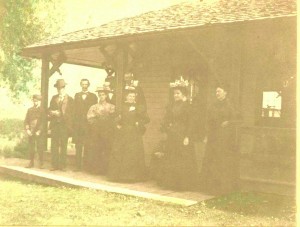 For the next decade after the end of the Civil War, the town struggled to rebuild its economy and repair the damage caused by the horrors of the conflict. As veterans of the war came home and resumed their work as tradesmen and merchants, the local economy did improve. In April 1867 the Virginia General Assembly granted a charter to the Winchester and Strasburg Railroad Company. As its name implied this company was authorized to construct a railroad line between Winchester and Strasburg, linking Newtown/Stephensburg and Middletown with the existing Winchester & Potomac Railroad to the North and the Manassas Gap Railroad to the south. As previously mentioned, the coming of the railroads signaled an end to the wagon-building industry, seriously diminishing the other hand-skill trades practiced in the town. At the same time, there were new benefits to the advent of railway travel. Local Merchants could begin to offer goods manufactured hundreds of miles away for more affordable prices. Day travel to places like Baltimore and Washington, D.C. required less time. Agricultural products that formerly had been hauled by local farmers in wagons to stations in Winchester or Strasburg could now be dropped off locally. In large measure, despite the negative effect they had on the town’s old staple wagon-building industry, the railroads helped the town to recover from the effects of the war a little more quickly than it would have otherwise.
For the next decade after the end of the Civil War, the town struggled to rebuild its economy and repair the damage caused by the horrors of the conflict. As veterans of the war came home and resumed their work as tradesmen and merchants, the local economy did improve. In April 1867 the Virginia General Assembly granted a charter to the Winchester and Strasburg Railroad Company. As its name implied this company was authorized to construct a railroad line between Winchester and Strasburg, linking Newtown/Stephensburg and Middletown with the existing Winchester & Potomac Railroad to the North and the Manassas Gap Railroad to the south. As previously mentioned, the coming of the railroads signaled an end to the wagon-building industry, seriously diminishing the other hand-skill trades practiced in the town. At the same time, there were new benefits to the advent of railway travel. Local Merchants could begin to offer goods manufactured hundreds of miles away for more affordable prices. Day travel to places like Baltimore and Washington, D.C. required less time. Agricultural products that formerly had been hauled by local farmers in wagons to stations in Winchester or Strasburg could now be dropped off locally. In large measure, despite the negative effect they had on the town’s old staple wagon-building industry, the railroads helped the town to recover from the effects of the war a little more quickly than it would have otherwise.
Just as the town was beginning to recover, an odd series of events caused by the heavy bureaucratic hand of the United States Postal Service eventually forced the town to change its name. The problem stemmed from the fact that there were almost a dozen other places in Virginia called “Newtown,” and there was one other community called “Stevensburg” in Culpeper County, Virginia. This caused a large number of letters and packages to go astray and made a lot of people very angry. Instead of assigning numbers to each town’s post office, the Postal Department in Washington, D.C informed the people of Newtown/Stephensburg in February of 1880 that the new name of their post office was going to be “Pantops.” Perhaps the panoramic views associated with Stephensburg’s setting in the Shenandoah Valley were the reason behind this new name. In any case, the people of the town were shocked and promptly protested. After a community meeting the town’s postmaster was sent to Washington with orders to have the ancient name restored. He returned with the news that the Postal Service was not going to change its mind but would consider any other name that was not already taken by another post office in Virginia. At a second town meeting the people of Stephensburg drafted a list of names that included the following: Newton City, Newtonburg, Newtonfield, Newtolona, Newtonapolis and Stephens City. The name Stephens City was chosen by popular vote, and word was sent to the Postal Department of the decision. Six days later the citizens were dismayed once again to learn that the Postal Service had not changed the name of the town’s post office to Stephens City but had assigned it the name Newtonfield. Once again the people of the town protested, and finally the town’s post office was officially re-christened Stephens City.
